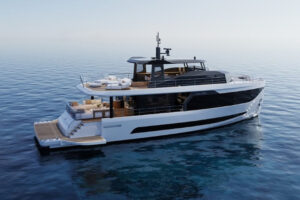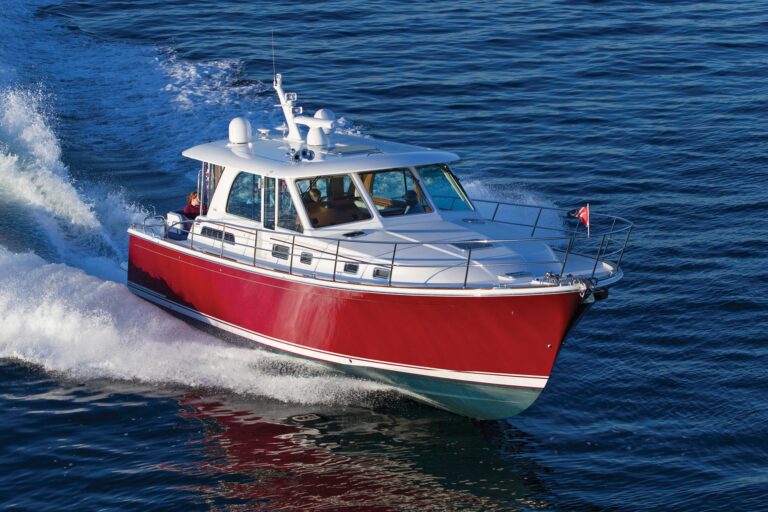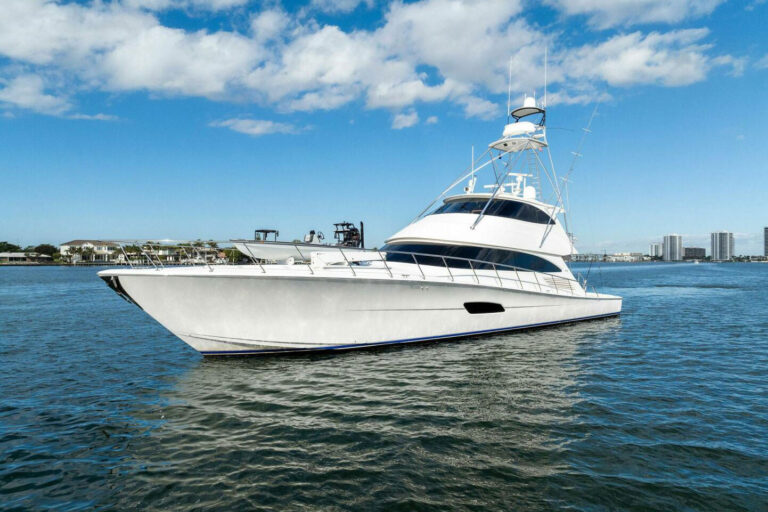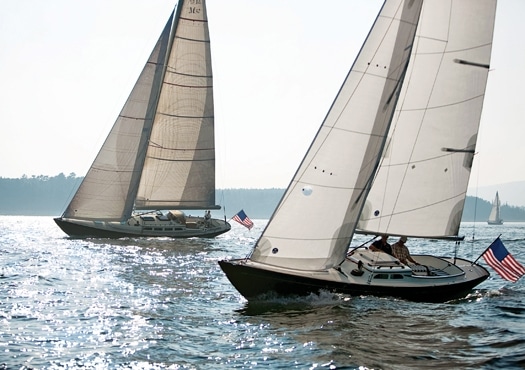
ytgnov17morris525.jpg
Lined up like schoolgirls at an old-fashioned dance, four captivating sailing yachts anxiously awaited the attentions of curious journalists and prospective buyers. Morris Yachts had assembled these attractive young ladies-an M29, an M36, an M42, and an M52-in Northeast Harbor, Maine, at the company’s commissioning and service location.
Sparkman & Stephens designed all of them, and they share a delightful aesthetic DNA that dates from the early 20th century-sailing’s so-called golden years. Below the waterline, though, each has the relatively shallow underbody, plus the high-aspect keel and rudder common to most modern boats. Each model also sports an up-to-date rig and sail plan. This has been a recipe for success-at this writing, Morris has sold 64 M36s, 18 M42s, and one each of the M29 and the M52. In addition to giving all these ladies extraordinary good looks, S&S designed the smaller models to be relatively easy and quick to build via molded modules for the interior, adding to the viability of series production and to the plus side of the builder’s bottom line.
Although in years past, Morris Yachts built most of its boats from stock designs by Chuck Paine, the yard offered its clients a reasonable number of custom options-and a few unreasonable ones, as well. The craftsmen assembled the interior of each from a large number of handmade wooden pieces, which added to the construction time and encouraged change orders from the client. This often compromised the company’s ability to earn a decent profit. In a sense, Morris marketed a service instead of its yachts. Having a line of production boats now anchors Morris’s marketing plan, allows the company to reach a broader audience, and lets management control costs more accurately. The M Series has been, and will be, very important to the future of Morris Yachts.
The M36, the first of the series, made its public debut in the summer of 2004. Morris Yachts had taken her to Mystic Seaport in July to celebrate the 75th Anniversary of Sparkman & Stephens, and, most important, to entice yachtsmen to place an order. That day, I fell in love with the M36 from a distance, as the late Tom Morris and his son, Cuyler, chauffeured prospective buyers among the moored yachts in the Mystic River. The following day, I was lucky enough to sail her with Tom. Fortune smiled upon me again in 2009, sending me to Northeast Harbor to sample the new M29 and M52.
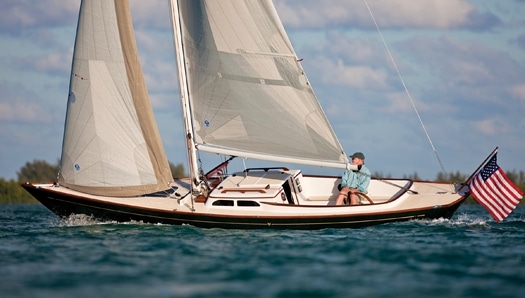
| | |
Although these yachts come from the same gene pool, they couldn’t differ more. The 29 is tiny, light in weight, as nimble as an elf-whether she’s under sail or power-and easy to deal with at sea, in the slip, or on the hard. She trailers happily behind most SUVs or pickups. In fact, Cuyler Morris dragged hull number one all over the East Coast to demo and race her. Influenced by the simplicity of the M36, the 29 has no aspirations beyond her role as a daysailer/club racer.
The M52 is pure luxury in the tradition of Morris Yachts’s current Ocean Series and all of the custom and semi-custom yachts that have emerged from the yard since luxury became the norm, rather than the exception, in the buyers’ expectations. Like the 42, this largest of the M Series is geared toward cruising, coupled with easy operation, and she should feel perfectly at home anywhere on the world’s oceans her owner chooses to venture.
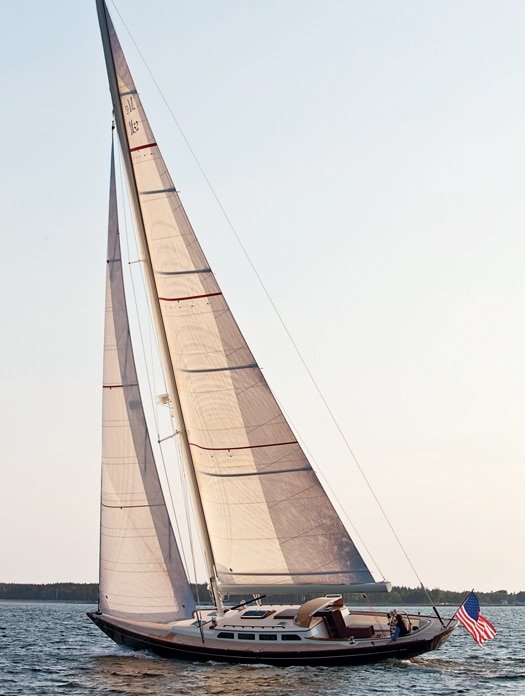
| | |
Luxury in this case mimics the style that the Herreshoffs established during the early years of the 20th century. Raised-panel bulkheads and tongue-and-groove overhead, painted in antique white, wash the interior in a soft glow, even on the overcast day of my visit. Natural light from the large butterfly hatch in the salon and the eight portlights in the trunk cabin lend a hand in the glowing department. Cherry trim, finished in glossy varnish, defines the spaces, establishing boundaries and enhancing the shapes of the doorways and furniture.
Of course, sailing is the main reason we buy yachts of this sort, but once we drop the anchor and go below for a rest, we’ll likely not be in a hurry to leave. I see myself curled up on the forward corner of the dinette, my drink close at hand on the drop-leaf table, reading Patrick O’Brian or listening to Antonio Vivaldi celebrate the four seasons. Later that night, tucked into my side of the queen berth in the master stateroom, the varnished cherry ceilings shimmering, I’ll welcome the sandman.
Alas, I paint a lonely portrait, but couples who like to cruise with friends or family or both won’t feel pinched for space on the 52, either. A large quarter-berth stateroom on the port side accommodates two adults, or children, and the dinette converts to a double berth. Each stateroom has a private head-the master also has a separate shower stall, while the aft cabin makes do with a wall-mount shower. A hatch in the overhead ventilates each head and provides a bit of natural light. Each stateroom has a full-height hanging locker, plus drawers for stowage. Anyone who bunks in the salon will have to share stowage space in either stateroom. This arrangement could be a problem on longer cruises, but who would cruise for more than a weekend with a full boat?
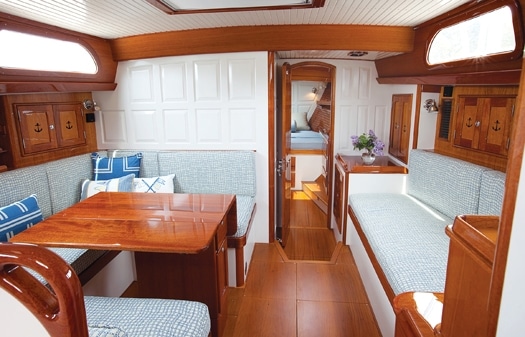
| | |
Cruising alone or with a small crowd, those who like to cook will find the galley more than up to any meal that requires less than a Viking super-range. At your service are a gimbaled three-burner propane stove, DC refrigeration, Corian countertops, and stowage for dinnerware, glasses, silverware, pans, and dry goods. The galley area forms a compact U-shape, which is safe to use while the boat is underway, because the chef can easily brace against the boat’s motion. It also shares that all-important glow that characterizes the rest of the interior.
As much as you’ll enjoy hanging out belowdecks, the boat is such a pleasure to sail that you may decide to carry on forever, like the Flying Dutchman. The M52’s Jefa rack-and-pinion steering is wonderfully smooth and precise, returning tactile sensations nearly as good as those given by high-quality tiller steering. Even in the light air of my sea trial, my fingertips told me what the rudder was doing. Although the 52 is orders of magnitude larger than the M29, she showed a similar willingness to respond to steering inputs, tacked quickly and reliably, and balanced well enough to make the autopilot seem redundant.
If we experienced more than 10 knots true wind speed on my sea trial, I missed the reading. Most of the time, we sailed in winds of 5 to 8 knots, and on a beam reach in 5 knots of true wind, the M52’s GPS showed 4 knots over the ground. Sailing at about 30 degrees to an apparent wind of 10 knots, the GPS showed 5.4 knots over the ground. This prowess in light air keeps the auxiliary quiet far longer than it would in lesser boats.
Electric winches and a Navtec hydraulic system for the vang and backstay take all of the labor out of sailing, making the M52 ideal for single-handed operation. All of the lines, save those that control the asymmetrical spinnaker, lead below the deck to rope clutches and then to the winches near the helm. The electric self-tailing winches just outboard of the helm manage the spinnaker.
When you reach your destination, simply roll up the jib and roll the mainsail into the Leisure furl aluminum boom. You’ll want to anchor out, if for no other reason than to use the slick counterweighted anchor deployment system designed by Peter Smith, Morris’s designer/engineer. It is beyond clever.
All of the traditional touches notwithstanding, the M52 is a thoroughly modern sailing yacht, and one worthy of being labeled an heirloom. Anyone who ventures offshore will want to add lifelines to the deck, but that’s a small aesthetic compromise in the name of safety. Otherwise, I wouldn’t change a thing.
Morris Yachts, (207) 244-5509; **www.morrisyachts.com**


